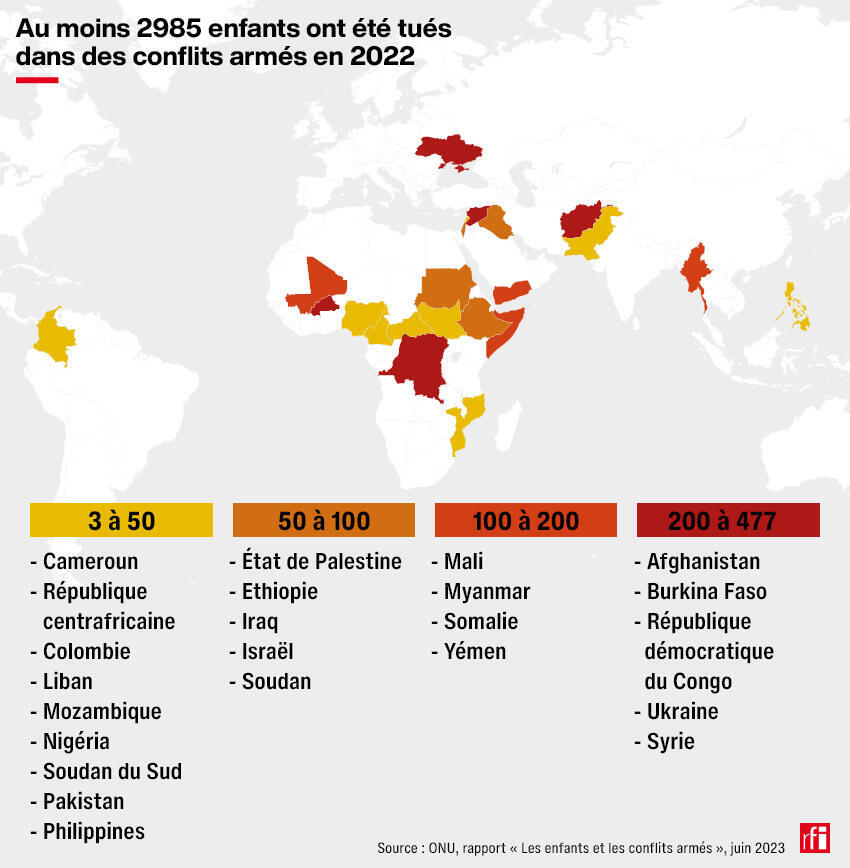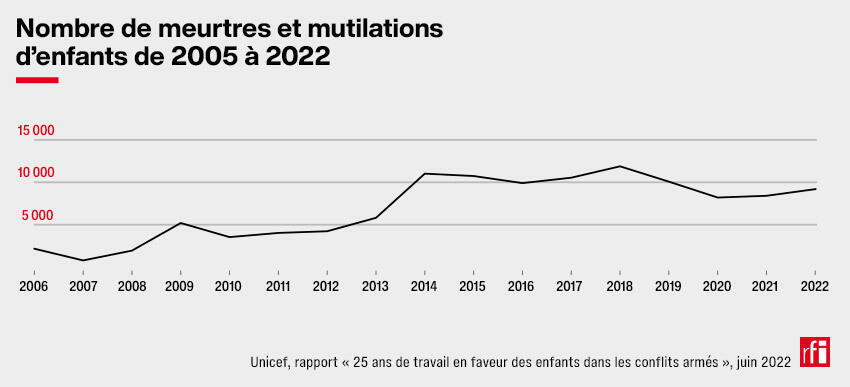On the occasion of International Children’s Rights Day, this November 20, several NGOs are recalling the extent to which young people are put in danger in times of war. In conflict zones, where more than 400 million children live, international law struggles to protect them.
As of November 7, after a month of conflict between Israel and Hamas, at least 4,237 Palestinian children had died in the Gaza Strip, according to figures put forward by the Palestinian Ministry of Health in the enclave. A chilling figure that is equivalent to twice the total number of Palestinian children killed in the West Bank and Gaza combined since 1967, according to the NGO Defense for Children International. “ Gaza becomes a cemetery for children », deplored the day before the Secretary General of the UN, Antonio Guterres, calling for a ceasefire “ immediate “.
For several NGOs, this sad record highlights the violations committed against young people in times of war, which continue to multiply. In 2019, more than one in six children lived in a conflict zone. In 2022, the UN counted 27,180 serious violations committed against children, including 8,630 murders and mutilations, a level never reached in nearly twenty years of censuses. “ These figures must be the symbol of the illegality of these attacks », Presses Bill van Esveld, deputy director of the children’s rights division at Human Rights Watch.
More and more victims
Behind the numbers, there are unspeakable horrors. The innocent victims of the Tigray war in Ethiopia, those killed in landmine explosions in Afghanistan, the recruitment of young people into armed groups in the Democratic Republic of Congo, minors executed as part of the “war on drugs » in the Philippines… So much violence which affects, if not targets, the most vulnerable.
To better identify them, the UN lists six types of violence specific to this segment of the population, namely murder, recruitment by armed groups, sexual violence, attacks against schools or hospitals, kidnappings and refusal to authorize access of humanitarian aid to children. For murder alone, the figure doubled compared to 2005. “ We have never reached such high levels of violence », alerts Lucile Grosjean, director of advocacy at Unicef France. “ What is happening in Gaza shows that the work is far from finished and that we are going backwards in the application and respect of international law. We are crossing a red line in terms of horror. »
Toy-like weapons
In situations of violence, massive population movements often break contact between children and their families. According to Unicef, at the end of 2022, a record number of 43.3 million children were living in situations of forced displacement. “ Because of this, they are even more vulnerable and end up carrying the heavy burden of a conflict that is not theirs. », summarizes Alyona Synenko, spokesperson for the International Committee of the Red Cross (ICRC). Alone, the latter are exposed to all kinds of abuse. “ We have child soldiers, military infrastructures installed in schools, the violation of the principle of proportionality… », she lists.
“ There are also many illegal weapons that have been largely banned, but are still used, such as cluster munitions or landmines. », adds Bill van Esveld. In 2023, according to the annual Landmine Monitor report, Russia, Myanmar and Ukraine have used antipersonnel landmines, although they are banned by a 1997 treaty. If these weapons do not explode in combat, they are left abandoned. Often, children live, play and go to school in areas riddled with these mines which prolong the conflict long after it is over. “ These weapons are by definition indiscriminate. They cannot distinguish between civilians and military targets and are guaranteed to kill innocent people, even minors. », Explains the member of Human Rights Watch.
Same problem for cluster munitions, also banned worldwide, which disperse small explosive charges. “ They are usually brightly colored, very small and infamous because children mistake them for toys. » In 2022, these remains caused at least 185 victims in Azerbaijan, Iraq, Laos, Lebanon, Syria, Ukraine and Yemen. Children represented 71% of the victims.
The “List of Shame”
To protect children from armed conflict, the UN publishes a report each year that identifies countries that have perpetrated violations of children’s rights. “ We call it the “list of shame”,” says Bill van Esveld. On the principle of “ name and shame ” (literally, ” name and shame “), this report provides information on each of these violations and encourages the named countries to reduce them. In the latest report, published in June 2023, Ukraine – as the scene of clashes between kyiv and Moscow – had the most child killings (477), totaling 2,334 serious violations. “ From this inventory, there is a lot of work that is undertaken with the parties to the conflict to develop action plans. », Supports Lucile Grosjean. “ This was very useful in the Democratic Republic of Congo, for example, where the recruitment of children into the armed forces was reduced after the signing of a plan in 2012. »

If the credibility of this list does indeed increase international pressure on countries where children are in danger, its objectivity is sometimes called into question. “ Human Rights Watch criticizes the Secretary-General for allowing this list to be politicized, because some countries are never listed due to political pressure “, rails Bill van Esveld, mentioning Saudi Arabia and denouncing the “ gymnastics performed » to evoke the State of Israel without ever actually listing it. “ There is generally controversy over who will appear on this blacklist because no country or armed group wants to appear on it. », recognizes Lucile Grosjean.
Enforce existing laws
A large part of the work of NGOs consists of trying to enforce international law, which multiplies the texts to protect the youngest. In theory, children benefit from general protection, namely the principle according to which the civilian population must not be the object of attacks, but also from specific provisions, which prohibit, among other things, any form of attack on modesty, recruitment into the armies, or even detention.
However, in practice, this international law is not always respected. “ There are several examples where the existing laws are very clear and the violations are just as clear, such as the attacks on hospitals in the Gaza Strip or Russia’s use of cluster munitions to attack the crowded Kramatorsk station “, warns Bill van Esveld, who is also pushing for laws to be more protective, by banning autonomous weapon systems and white phosphorus. “ Current laws allow us to differentiate between humanity and inhumanity, there is an urgent need to reaffirm them », Urges Lucile Grosjean.
The only obstacle: the time required for justice, which is either very long or non-existent. When conflicts end, priority is often given to reconstruction, to the detriment of the courts. “ There is not enough justice », deplores the director of advocacy at Unicef France, who points to sometimes failing national judicial systems and an International Criminal Court which only deals with the most serious crimes. “ If a soldier commits violations against children, he must be prosecuted by the army itself. In some cases this never happens, or for minor infractions “, says Bill van Esveld. Some NGOs, such as Human Rights Watch, have been advocating for several years for national courts to be given “universal jurisdiction”, which would allow the alleged perpetrators of these violations to be prosecuted, regardless of their nationality and the place where these crimes took place. been committed.
